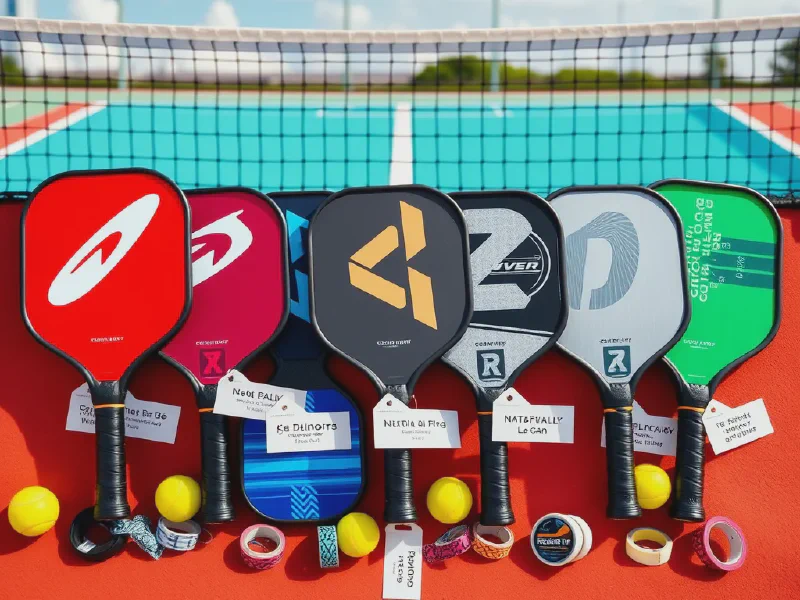Top Pickleball Paddle Brands Reviews and Comparisons

The Complete Guide to Pickleball Paddles
Pickleball paddles are essential equipment for one of the fastest-growing sports in the United States. The right paddle can significantly enhance a player's performance and overall enjoyment of the game. Several factors, including materials, size, shape, and brand reputation, play crucial roles in selecting the ideal pickleball paddle.
Modern pickleball paddles come in various designs and materials, affecting their performance on the court. Players can choose from wood paddles, which are typically heavier and more affordable, to high-tech composite paddles that offer better control and power without sacrificing weight. Understanding the differences between these paddles is vital for any pickleball enthusiast.
Beyond just materials, the size and shape of a paddle can impact how a player interacts with the ball. Wider paddles provide a larger sweet spot but may sacrifice speed and maneuverability, while smaller paddles offer precision but require more skill and practice. Knowing which paddle shape suits one's playing style is essential for optimal performance.
Taking care of your pickleball paddle is just as important as selecting the right one. Proper maintenance ensures the longevity of the paddle and keeps it performing at its best. From cleaning to storage, understanding how to care for both wooden and composite paddles can help players maintain their equipment in top condition.
As pickleball continues to grow in popularity, so does the range of paddles available on the market. This article aims to provide an overview of the best pickleball paddle brands, reviews of popular paddles, comparisons of materials, an explanation of sizes and shapes, and maintenance tips to keep your paddles in peak condition.
Best Pickleball Paddle Brands
When selecting a pickleball paddle, examining the brand is essential. Top brands have built reputations for quality, performance, and innovation in the pickleball community. Look for brands that have been endorsed by professional players and those that emphasize customer satisfaction.
Leading brands include Paddletek, Selkirk, Onix, and Engage, all known for their cutting-edge technology and durable designs. Each brand offers various models catering to different playing styles, skill levels, and price ranges, allowing players to find their perfect match.
Brand reputation often comes with endorsements from professional players, which can greatly influence purchasing decisions. Many of the top brands collaborate with renowned pickleball athletes to develop paddles that meet the performance standards elite players expect, lending credibility to their products and further cementing their status in the market.
Reviews of Popular Pickleball Paddles
Among the best-selling paddles, the Paddletek Tempest Wave Pro stands out due to its balanced feel and excellent control. Players appreciate its lightweight design and large sweet spot, perfect for both beginners and advanced players. The Selkirk Amped series is also highly rated for its durability and power, making it ideal for aggressive playstyles.
When analyzing features, players consider aspects such as weight, grip size, and surface texture. For instance, paddles like the Onix Z5 offer a graphite face for added power, while the Engage Encore line emphasizes control and spin, catering to a variety of players. Understanding these features helps in making informed purchasing decisions.
User ratings provide additional insights into the performance and satisfaction levels associated with specific paddles. For example, many reviews highlight the comfort and grip of the Paddletek paddles, while others might point to the power generated by paddles from Selkirk. These insights are invaluable when choosing a paddle.
Comparing Paddle Materials
When it comes to paddle materials, both wood and composite variations offer distinct advantages. Wooden paddles are usually more affordable and durable but are heavier, while composite paddles, made from materials like fiberglass and polypropylene, provide a lightweight design with varying degrees of power and control.
Weight plays a significant role in a player's performance, as lighter paddles generally allow for faster swings and better maneuverability. Heavy paddles can offer more power on hits but might tire players more quickly, particularly in longer games. Understanding your playing style can help determine the best weight for you.
In terms of durability, composite paddles tend to maintain their performance longer than wooden ones but come at a higher cost. Prices vary greatly with composite models, so players need to consider their budget while balancing performance needs against paddle longevity.
Paddle Sizes and Shapes Explained
Paddle shapes can vary from traditional rectangular designs to wider paddle faces that enhance the sweet spot. Players often find that wider paddles may help in casual play, while those who prefer to play competitively may lean towards narrower shapes that allow for more precision and speed.
Choosing the right paddle size is crucial for achieving comfort during play. A standard paddle size typically measures 15.5 to 17 inches in length and 7.5 to 8.5 inches in width. Players should also consider grip sizes and how they affect control, ensuring that the paddle fits well in hand without causing strain.
The impact of paddle shape and size on performance is substantial, as different shapes can influence how the paddle strikes the ball. Players must experiment with various paddles to determine which combination best suits their style and enhances their game.
Maintenance of Pickleball Paddles
Caring for wooden and composite paddles requires different maintenance routines. Wooden paddles should be dried after play to prevent warping, while composite paddles can typically endure moisture better but should still be kept clean and free from debris.
Cleaning your paddle after use helps maintain its performance. Use mild soap and water for composite paddles, avoiding harsh chemicals that could damage the surface. Store paddles in a protective cover to prevent scratches and impacts when not in use.
Players should regularly check for signs of wear, such as cracks or a loss of grip. When paddles begin to show significant damage or no longer perform as they did initially, it may be time to invest in a new paddle to ensure peak performance on the court.